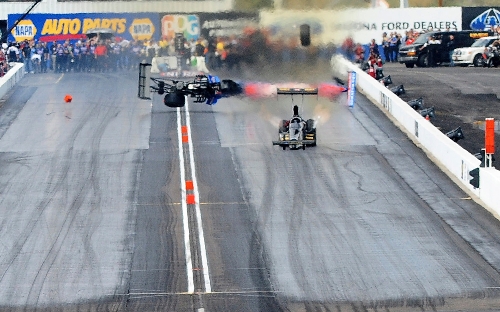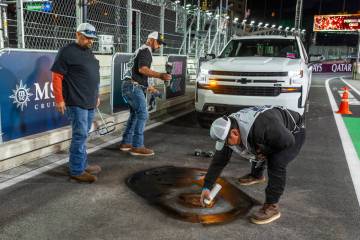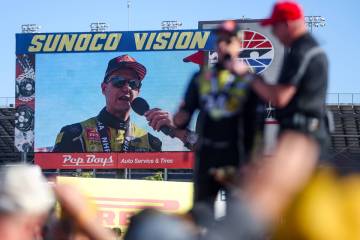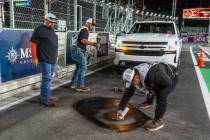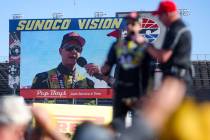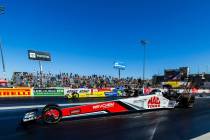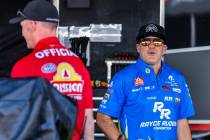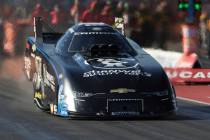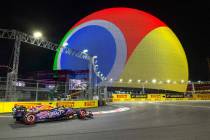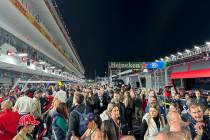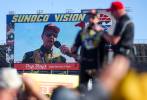NHRA teams develop wheel-restraint systems after Arizona tragedy
It was a racer's worst nightmare, one that Antron Brown will never forget.
On Feb. 21, during the first round of eliminations at Firebird International Raceway near Phoenix, spectator Sue Zimmer, 52, of Rice Lake, Wis., was killed after being hit by a tire and wheel that flew from Brown's Top Fuel dragster.
"Every accident hits you hard," said Brown, who in recent years witnessed the deaths of drag racing friends Darrell Russell, Eric Medlen and Scott Kalitta. "We take the risks as racers.
"But a spectator getting killed takes the wind out of your sails like nothing else at the track."
Brown's dragster lost traction about 300 feet past the starting line, and its left rear racing slick broke away, apparently after at least one wheel stud broke.
The spectator death by a flying part off a dragster is believed to be the first such fatality at an NHRA national event in more than 40 years. The pain still lingers for Brown and the racing organization, which brings its SummitRacing.com NHRA Nationals to Las Vegas Motor Speedway today for a three-day run.
"Somebody got killed by a part that came off my race car," said Brown, who suffered minor bruises in the crash. "When I heard that happened, I dropped to my knees.
"I have to learn how to deal with that for the rest of my life."
After the tire and wheel came off Brown's Don Schumacher Racing dragster, the car immediately veered left into a guardwall. The rolling 80-pound tire and wheel then hit the side of the dragster and went airborne. According to reports, it bounced in front of the main grandstands, sailed over the end of the structure and slammed into Zimmer while she was in the pit area.
A preliminary report from a metallurgist commissioned by the NHRA indicated at least one of Brown's wheel studs had cracks, which allowed the wheel to break free from the 8,000-horsepower dragster when the tires lost traction, commonly called "tire shake" in drag racing.
"You try to anticipate everything," said Graham Light, vice president of competition for the NHRA and a former Top Fuel driver.
Don Schumacher, who owns Brown's race team, said he is "100 percent sure the wheel was torqued (tightened) on."
"It wasn't a human error," he said. "It was just a horrific series of events."
Schumacher owns three Top Fuel and three Funny Car teams and drove a Funny Car when the category was created in the late 1960s. He doesn't recall a spectator fatality at an NHRA professional tour event, but that hasn't lessened the impact he's felt since the Arizona race.
"Very catastrophic. I continue to deal with it on a day-to-day basis emotionally," he said. "I owned the car that did this. It was such a freak accident, but it doesn't make it any easier -- to say the least -- for the woman's family and friends."
The drag racing community was quick to react.
Not only did manufacturers replace wheel studs before the next NHRA event three weeks later, but two race teams quickly helped to develop separate wheel-restraint systems that have been approved by the NHRA, although it's uncertain either will be used this weekend.
Ed "Ace" McCulloch, crew chief for Schumacher's Funny Car driven by Ron Capps, worked with Strange Engineering to develop one system; Funny Car veteran and engineer Jim Head worked with Chrisman Driveline Components on another. Light said the systems are similar. With axles on Top Fuelers and Funny Cars being hollow, a tube was made that slides through the axle with a flange attached outside each wheel and connected with a large nut or hub.
"That would prevent a wheel from coming off if studs broke again," said Lee Beard, who oversees each of Schumacher's racing operations. "Safety is as important to us as performance is."
Race car debris flying into spectator areas has been of greater concern to racing officials in all organizations for more than 10 years.
In 1999, most major oval racetracks -- catering to open-wheel and/or stock car racing -- extended the height of safety fencing in front of grandstands after a tire, wheel and suspension assembly flew from a crashed IndyCar into the Charlotte Motor Speedway crowd and killed three spectators. Debris from NASCAR stock cars has also injured fans.
Safety catch fencing at major NASCAR oval tracks is about 21 feet high and overhangs the track, but fencing at most dragstrips is only 4 feet high. At Las Vegas, however, the main grandstand is elevated about 8 feet above the racing surface, and an additional 4-foot fence provides a 12-foot barrier between the track and nearly all spectators.
Light and most in drag racing do not think NASCAR-style fencing is needed at their events.
"We've looked at (adding) catch fences, but our sport is different," he said. "It's not NASCAR (oval racing) or road racing, where cars are always going to be pointed toward grandstands. Ours is straight-line (racing), and normally that's where the momentum continues.
"Phoenix was an extremely rare situation, but we haven't taken it lightly. We're working to prevent an incident from happening in the first place."
Schumacher, whose son Tony has won the past six Top Fuel championships, is confident the new wheel studs will prevent a similar incident. And he thinks the new wheel-restraint devices -- which will be tested for a second time Monday at Las Vegas -- will be an effective added safeguard.
"As racers, we all realize some of the danger we're putting ourselves in, from the drivers to crew members standing near the starting line," Don Schumacher said. "We take risk and accept that.
"But no one ever expected a spectator to be killed by a race car in our sport."
Contact reporter Jeff Wolf at jwolf@reviewjournal.com or 702-383-0247.



